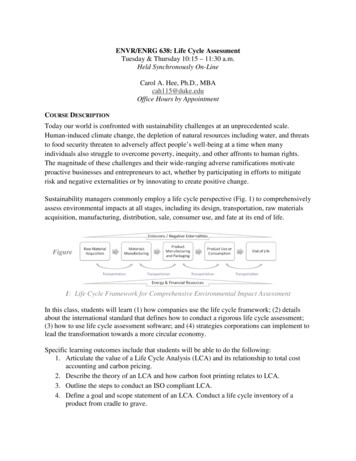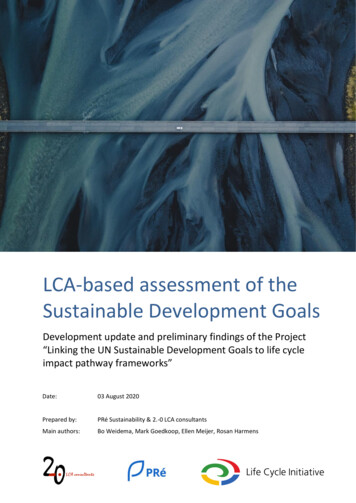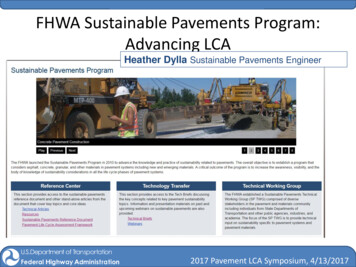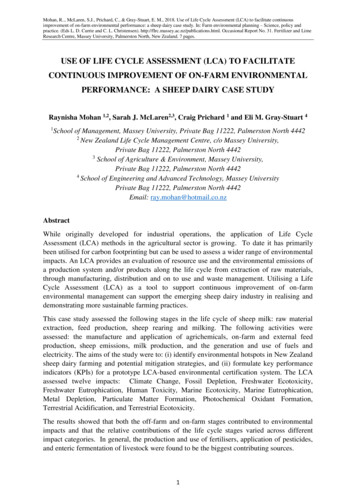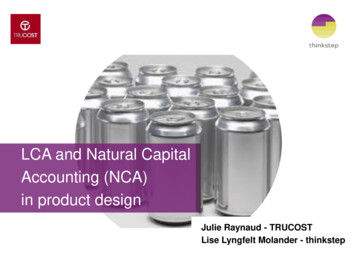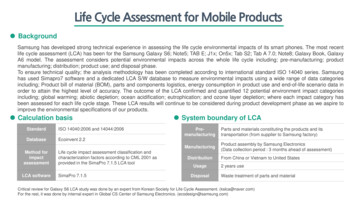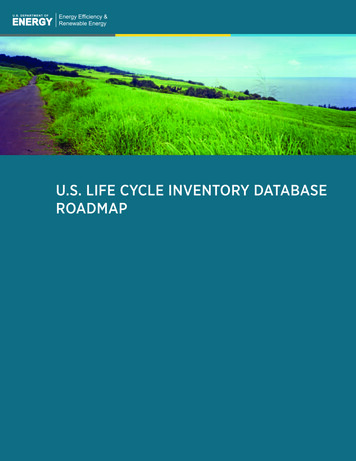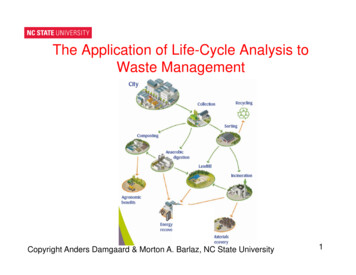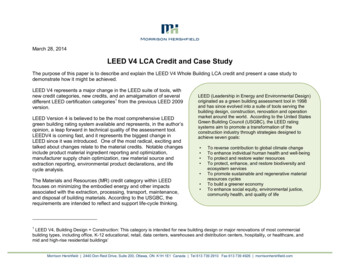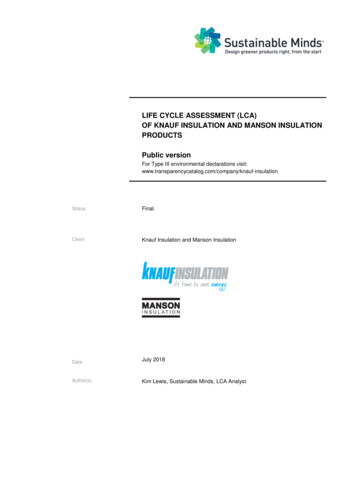
Transcription
LIFE CYCLE ASSESSMENT (LCA)OF KNAUF INSULATION AND MANSON INSULATIONPRODUCTSPublic versionFor Type III environmental declarations sulationStatusFinalClientKnauf Insulation and Manson InsulationDateJuly 2018Author(s)Kim Lewis, Sustainable Minds, LCA Analyst
Contents1INTRODUCTION . 51.1 Opportunity . 51.2 Life Cycle Assessment . 51.3 Status . 61.4 Team . 61.5 Structure . 62GOAL AND SCOPE . 72.1 Intended application and audience . 72.2 Insulation products . 72.3 Functional unit . 112.4 System boundaries . 122.4.1.Raw materials acquisition andtransportation (A1-A2). 132.4.2.Manufacturing (A3) . 142.4.3.Distribution (A4) . 142.4.4.Installation (A5) . 142.4.5.Use (B1-B7) . 142.4.6.Deconstruction (C1) . 142.4.7.Transport (C2) . 142.4.8.Waste processing (C3) . 152.4.9.Disposal (C4) . 153INVENTORY ANALYSIS . 163.1 Data collection . 163.2 Primary data . 163.2.1.Raw Materials acquisition andtransportation (A1-A2). 173.2.2.Manufacturing (A3) . 233.2.3.Distribution (A4) . 243.2.4.Installation (A5) . 253.2.5.Use (B1-B7) . 263.2.6.Deconstruction (C1) . 263.2.7.Transport (C2) . 263.2.8.Waste processing (C3) . 263.2.9.Disposal (C4) . 263.3 Data selection and quality . 273.4 Background data. 283.4.1.Fuels and energy . 283.4.2.Raw materials production . 283.4.3.Transportation . 303.4.4.Disposal . 303.4.5.Emissions to air, water, and soil. 303.5 Limitations. 313.6 Criteria for the exclusion of inputs and outputs . 313.7 Allocation . 323.8 Software and database . 333.9 Critical review . 33Page 3
4IMPACT ASSESSMENT METHODS . 344.1 Impact assessment . 344.2 Normalization and weighting . 345ASSESSMENT AND INTERPRETATION. 365.1 Resource use and waste flows . 365.2 Life cycle impact assessment (LCIA) . 515.2.1.EcoBatt Insulation . 515.2.2.Jet Stream Ultra and EcoFill WxBlowing Wool Insulation . 545.2.3.JetSpray Thermal Insulation . 555.2.4.Atmosphere Duct Liner & Wall andCeiling Liner M (and AKOUSTI-LINER and AKOUSTI-SHIELD ) . 565.2.5.Atmosphere Duct Wrap (andALLEY WRAP B ) and KN UtilityInsulation . 585.2.6.Akousti-Board Black . 605.2.7.BlackAcousticalBoardandAcoustical Smooth Board. 615.2.8.Earthwool Insulation Board (andAK BOARD ) . 635.3 Sensitivity analysis . 655.4 Overview of relevant findings . 655.5 Discussion on data quality . 665.6 Completeness, sensitivity, and consistency . 675.7 Conclusions, limitations, and recommendations . 676SOURCES . 68ACRONYMS . 69GLOSSARY . 69APPENDIX A. USED DATASHEETS . 71Page 4
1INTRODUCTION1.1OpportunityKnauf Insulation is striving to develop and bring to market products and solutions that willbe vital in supporting the construction sector to deliver a low energy and sustainable builtenvironment. To honor our commitment to sustainability, it is important that we conductLife Cycle Assessments to evaluate the environmental impacts of our products in allstages of life, from raw materials to manufacturing and through to the end of life. The goalof conducting a Life Cycle Assessment is to explore the full range of environmentalimpacts our products have and to identify ways to improve processes and reduce impacts.This project is critical to Knauf Insulation’s commitment to provide the market with theinformation it needs to be able to properly assess the environmental impact of ourproducts/solutions.In order to understand the true impact of products throughout all life cycle stages, KnaufInsulation has chosen to conduct the Life Cycle Assessment using a cradle-to-graveapproach. By factoring in all stages, we are more informed on how to reduce impacts ona broader scale.Knauf Insulation is interested in having Life Cycle Assessment (LCA) data available forits most important products to be able to obtain a Sustainable Minds TransparencyReport , a Type III Environmental Declaration that can be used for communication withand amongst other companies, architects, and consumer communication, and that canalso be utilized in whole building LCA tools in conjunction with the LCA background reportand LCI.Knauf Insulation commissioned Sustainable Minds to help develop LCAs for our mostimportant insulation products. Knauf Insulation wants to learn from the results and islooking forward to having guidance for future product improvements that can be deducedfrom the results.1.2Life Cycle AssessmentThis life cycle assessment (LCA) follows the UL Environment (ULE) PCR for BuildingEnvelope ThermalInsulation v2.0, which was updatedand republished under the Part Aand Part B format to conform to EN15804 and ISO 21930:2017 [1]. Thisreport includes the following phases: Goal and ScopeInventory AnalysisImpact AssessmentInterpretationAn ISO 14040-44 third-party reviewand a third-party report verification for Transparency Reports are required in order to usePage 5
Transparency Reports as Type III Environmental Declarations. The third-party review andthird-party Transparency Report verification will both be completed in this project.1.3StatusAll information in this report reflects the best possible inventory by Knauf Insulation at thetime it was collected, and best practices were conducted by Sustainable Minds and KnaufInsulation employees to transform this information into this LCA report. The data coversannual manufacturing data for 10/2015-09/2016 from three of Knauf Insulation’smanufacturing locations: Shelbyville, IN; Lanett, AL; and Shasta Lake, CA. Where datawas missing, assumptions were made from manufacturing data for the three facilitiesbased upon expertise from Knauf Insulation employees.This study includes primary data from the processes at the three manufacturing facilities,secondary data from vendors that have been contracted, and literature data to completethe inventory and fill gaps where necessary.Knauf Insulation has chosen to have the LCA report undergo third-party review and theTransparency Reports undergo third-party verification. This review and verification will beperformed by NSF to assess conformance to ISO 14040/14044 and the ULE PCRs.1.4 TeamThis report is based on the work of the following LCA project team members on behalf ofKnauf Insulation:Scott Miller, Director Knauf AcademyScott has been assisted by numerous Knauf Insulation employees during the datacollection, reporting, and interpretation phases. 1.5From Sustainable Minds:Kim Lewis, LCA PractitionerStructureThis report follows the following structure: Chapter 2: Goal and scope Chapter 3: Inventory analysis Chapter 4: Impact assessment Chapter 5: Interpretation Chapter 6: SourcesThis report includes LCA terminology. To assist the reader, special attention has beengiven to list definitions of important terms used at the end of this report.Page 6
2GOAL AND SCOPEThis chapter explains the starting points for the LCA. The aim of the goal and scope is todefine the products under study and the depth and width of the analysis.2.1Intended application and audienceThis report intends to define the specific application of the LCA methodology to the lifecycle of Knauf Insulation products. It is intended for both internal and external purposes.The intended audience includes the program operator (Sustainable Minds) and reviewerswho will be assessing the LCA for conformance to the PCRs, as well as Knauf internalstakeholders involved in marketing and communications, operations, and design. Resultspresented in this document are not intended to support comparative assertions within thisstudy. However, the results will be disclosed to the public in Sustainable MindsTransparency Reports (Type III Environmental Declarations per ISO 14025) which arefocused on products that are available in the US market. These Transparency Reportswill undergo critical review for conformance to the PCRs.2.2Insulation productsWith more than 30 years of experience in the insulation industry, Knauf Insulationrepresents one of the fastest growing and most respected names in insulation worldwide.As a manufacturer of fiberglass insulation products, Knauf Insulation is interested indemonstrating its sustainability leadership and leveraging business value associated withtransparent reporting of its products’ cradle-to-grave environmental impacts. For moreinformation on Knauf Insulation products, go to http://www.knaufinsulation.com/en.In addition to the Knauf-branded products, Manson-branded products are also beingevaluated in this study. Here is a list of the Knauf products with their Manson counterparts,which are exactly the same from cradle to grave as their Knauf counterparts except forbranding (i.e. the way ink is printed on the packaging) [7]:Knauf brand nameAtmosphere Duct WrapAtmosphere Duct LinerBlack Acoustical BoardEarthwool Insulation BoardWall and Ceiling Liner MManson brand nameALLEY WRAP BAKOUSTI-LINER Akousti-Board Black AK BOARD AKOUSTI-SHIELD The Manson product Manson Alley K Pipe Insulation is the same as Knauf EarthwoolPipe Insulation with a de minimis exception, and it was not part of this updated LCA dueto the unavailability of a new PCR for mechanical products at the time of publication. TheLCA for pipe insulation will be updated when a new mechanical insulation PCR isavailable. See “Knauf Insulation Products LCA Background Report, Knauf 2017” for theLCA results for pipe insulation.The products studied in this report are listed in Table 2.2a with their facing optionsspecified where applicable. Some products in this report have previously been studied asPage 7
part of an LCA, also indicated in Table 2.2a. Manufacturing locations, declaration nameswith products represented and type of declaration, and other product information for eachproduct are listed in Tables 2.2b, 2.2c, and 2.2d, respectively.Different than the 2017 Knauf LCA study, some products which were previously combinedinto an average declaration have now been separated to conform to the new ULE Part Av3.1 section 2.5.2 rules regarding variation. Sets of results which are required by the PCRare now reported separately per product within their respective Transparency Reports. For EcoBatt Insulation, faced products differed in at least one environmentalimpact indicator by more than 10%; therefore, they were not combined as anaverage. For Atmosphere Duct Wrap and ALLEY WRAP B, faced and unfacedproduct differed in at least one environmental impact indicator by more than10%; therefore, they were not combined as an average. For Earthwool Insulation Board and AK BOARD , faced products differed inat least one environmental impact indicator by more than 10%; therefore, theywere not combined as an average.Black Acoustical Board and Acoustical Smooth Board differed less than 10% for allenvironmental impact indicators, and the weighted coefficient of variation across allproducts was less than 20% for any impact category; therefore, they remained combinedas an average.Table 2.2a Product names and facing optionsProduct nameEcoBatt InsulationJet Stream Ultra BlowingWool InsulationEcoFill Wx Blowing WoolInsulationJetSpray ThermalInsulationAtmosphere Duct Liner andAKOUSTI-LINER Wall and Ceiling Liner M andAKOUSTI-SHIELD Atmosphere Duct Wrapand ALLEY WRAP BKN Utility InsulationBlack Acoustical Board andAkousti-Board Black Acoustical Smooth BoardEarthwool Insulation Boardand AK BOARD Page 8Facing optionsUnfacedKraftFSKFoilPrevious N/ANoNoNoN/ANoN/AUnfacedASJ FSKNoNoNoNo
Table 2.2b Manufacturing locationsProduct nameEcoBatt InsulationJet Stream Ultra Blowing Wool InsulationEcoFill Wx Blowing Wool InsulationJetSpray Thermal InsulationAtmosphere Duct Liner and AKOUSTILINER Wall and Ceiling Liner M and AKOUSTISHIELD Atmosphere Duct Wrap and ALLEY WRAP BKN Utility InsulationBlack Acoustical Board and Akousti-BoardBlack Acoustical Smooth BoardEarthwool Insulation Board and AK BOARD Manufacturing location(s)Shelbyville, IN and Shasta Lake, CAShelbyville, IN and Shasta Lake, CAShelbyville, IN and Shasta Lake, CAShelbyville, IN and Shasta Lake, CAShelbyville, INShelbyville, INShelbyville, IN; Lanett, AL; Shasta Lake, CAShelbyville, IN; Lanett, AL; Shasta Lake, CAShelbyville, INShelbyville, INShelbyville, INTable 2.2c Declaration names with products represented and type of declarationTransparency ReportnameEcoBatt InsulationJet Stream Ultra andEcoFill Wx Blowing WoolInsulationJetSpray ThermalInsulationAtmosphere Duct Liner &Wall and Ceiling Liner MAKOUSTI-LINER andAKOUSTI-SHIELD Atmosphere Duct Wrapand KN Utility InsulationProduct name(s)EcoBatt Insulation unfacedEcoBatt Insulation kraft-facedEcoBatt Insulation foil-facedEcoBatt Insulation FSK-facedJet Stream Ultra Blowing WoolInsulationEcoFill Wx Blowing Wool InsulationJetSpray Thermal InsulationAtmosphere Duct LinerWall and Ceiling Liner MAKOUSTI-LINER AKOUSTI-SHIELD Atmosphere Duct Wrap unfacedAtmosphere Duct Wrap FSK-facedKN Utility InsulationALLEY WRAP B unfacedALLEY WRAP BALLEY WRAP B FSK-facedBlack Acoustical Board andAcoustical Smooth BoardBlack Acoustical BoardAcoustical Smooth BoardAkousti-Board Black Akousti-Board Black Earthwool InsulationBoardAK BOARD Page 9Earthwool Insulation Board unfacedEarthwool Insulation Board FSK-facedEarthwool Insulation Board ASJ facedAK BOARD unfacedAK BOARD FSK-facedAK BOARD ASJ -facedType of declarationFour specific products as anaverage from several of themanufacturer’s plantsA specific product as an averagefrom several of themanufacturer’s plantsA specific product as an averagefrom several of themanufacturer’s plantsA specific product from amanufacturer’s plantA specific product from amanufacturer’s plantThree specific products as anaverage from several of themanufacturer’s plantsTwo specific products as anaverage from several of themanufacturer’s plantsAn average product from amanufacturer’s plantA specific product from amanufacturer’s plantThree specific products from amanufacturer’s plantThree specific products from amanufacturer’s plant
Table 2.2d Other product informationCSI MasterFormat Transparency Report nameApplicationclassificationThermal and acoustical barriers for energyefficient construction. They can be used in newand retrofit wood and metal frame applicationsEcoBatt Insulation07 21 00in residential and commercial structures, as wellas in manufactured housing. These applicationsinclude thermal and acoustical treatments towalls, ceilings and floors.At the installation site, loose fill is installed usinga blowing wool machine and blown into openJet Stream Ultra and EcoFill attics or closed cavities. It can be used to07 21 26dense-pack sidewalls using the drill and fillWx Blowing Wool Insulationtechnique common in retrofitting homes or inhome weatherization activities.Spray-on insulation system installed using ablowing wool machine and water pump, used to07 21 29activate the powdered adhesive. It is sprayedJetSpray Thermal Insulationonto exterior and interior cavity walls for thermaland acoustical performance.Specifically designed for sheet metal ducts usedin heating, ventilating, and air conditioning. Itprovides an optimum combination of efficientsound absorption, low thermal conductivity, andminimal airstream surface friction. Wall &Atmosphere Duct Liner & Wall07 21 00Ceiling Liner is designed for use as anand Ceiling Liner Macoustical and visual barrier for walls andceilings where a black surface is required. It isprimarily used in theaters, sound studios, publicconcourses and other areas where acousticaltreatment is needed.Specifically designed for sheet metal ducts usedin heating, ventilating, and air conditioning. Itprovides an optimum combination of efficientsound absorption, low thermal conductivity, andminimal airstream surface friction. Wall &AKOUSTI-LINER and07 21 00Ceiling Liner is designed for use as anAKOUSTI-SHIELD acoustical and visual barrier for walls andceilings where a black surface is required. It isprimarily used in theaters, sound studios, publicconcourses and other areas where acousticaltreatment is needed.External insulation on commercial or residentialheating or air conditioning ducts. It is suitable forthe exterior of rectangular or round sheet metalducts and spaces or surfaces wheretemperature and condensation must beAtmosphere Duct Wrap and KNcontrolled. KN Utility Insulation is used as07 21 00thermal and/or acoustical insulation in theUtility Insulationappliance, equipment, industrial, commercial,and marine markets. KN Insulation has beensuccessfully used as a Red List free andformaldehyde-free core in double wall ductsystems.External insulation on commercial or residentialheating or air conditioning ducts. It is suitable forthe exterior of rectangular or round sheet metalducts and spaces or surfaces wheretemperature and condensation must becontrolled. KN Utility Insulation is used as07 21 00ALLEY WRAP Bthermal and/or acoustical insulation in theappliance, equipment, industrial, commercial,and marine markets. KN Insulation has beensuccessfully used as a Red List free andformaldehyde-free core in double wall ductsystems.Designed for use as acoustical insulation and/orBlack Acoustical Board anda visual barrier on walls and ceilings, where07 21 13system design requires a rigid product andAcoustical Smooth Boardwhere additional strength and abuse resistancePage 10ASTM or ANSI product specification ASTM C 665; Type 1, Class A (unfaced) ASTM C 665; Type II, Class C (kraft faced) ASTM C 665; Type III, Class A (FSK-25foil faced) ASTM C 665; Type III, Class B (foil faced) ASTM C764; Type I ASTM C1014 ASTM C1071; Type I ASTM C 665 ASTM C1071; Type I ASTM C 665 ASTM C 1139 - unfaced; Type I, Type II;Grade 1 - 0.75 lb/ft3; Grade 2 - 1.0 lb/ft3;Grade 3 - 1.5 lb/ft3 (Duct Wrap) ASTM C 553; Type I, II, III (Duct wrap) ASTM C553: Type I, Type II (KN UtilityInsulation) ASTM C 1139 - unfaced; Type I, Type II;Grade 1 - 0.75 lb/ft3; Grade 2 - 1.0 lb/ft3;Grade 3 - 1.5 lb/ft3 ASTM C 553; Type I, II, III ASTM C612; Type IA and Type IB
are required. The black surface provides avisual barrier with an aesthetic appearance, inboth wall and ceiling applications.Akousti-Board Black 07 21 1307 21 13Earthwool Insulation BoardAK BOARD 07 21 132.3Acoustical Smooth Board is a versatile productfitting for a variety of acoustical applicationssuch as office partitions, interior panels, andsound baffles.Designed for use as acoustical insulation and/ora visual barrier on walls and ceilings, wheresystem design requires a rigid product andwhere additional strength and abuse resistanceare required. The black surface provides avisual barrier with an aesthetic appearance, inboth wall and ceiling applications.Versatile product for thermal and acousticalapplications such as: heating and airconditioning ducts, power and processequipment, boiler and stack installations, metaland masonry walls, wall and roof panelsystems, curtain wall assemblies, and cavitywalls.Versatile product for thermal and acousticalapplications such as: heating and airconditioning ducts, power and processequipment, boiler and stack installations, metaland masonry walls, wall and roof panelsystems, curtain wall assemblies, and cavitywalls. ASTM C612; Type IA and Type IB ASTM C612: Type IA (1.6, 2.25, 3.0, 4.25,6.0 pcf), Type IB (3.0, 4.25, 6.0 pcf) ASTM C795 ASTM C1136: Type I, II, III, IV, VIII(ASJ ), Type II, IV (FSK) ASTM C612: Type IA (1.6, 2.25, 3.0, 4.25,6.0 pcf), Type IB (3.0, 4.25, 6.0 pcf) ASTM C795 ASTM C1136: Type I, II, III, IV, VIII(ASJ ), Type II, IV (FSK)Functional unitThe results of the LCA in this report are expressed in terms of a functional unit, as itcovers the entire life cycle of the products. Per the PCR [1], the functional unit is:1 m2 of installed insulation material with a thickness that gives an averagethermal resistance RSI 1 m2·K/W and with a building service life of 75 years(packaging included)Building envelope thermal insulation is assumed to have a reference service life equal tothat of the building, which in this case is 75 years [1]; however, the expected service lifeof fiber glass under ideal conditions is usually stated at 100 years or more [7]. Therefore,the insulation does not need to be replaced, and 1 m2 of insulation plus facing andpackaging is required to fulfill the functional unit. This reference service life applies for thereference in-use conditions only.Reference flows express the mass of product required to fulfill the functional or declaredunit and are calculated based on the nominal insulation density for the R-value closest toRSI 1 m2·K/W, which varies for each product. Reference flows are listed in Table 2.2e.Page 11
Table 2.2e Reference ass(kg)EcoBatt 70.00460.00460.00460.0472N/A00.00550.0133Jet Stream Ultra BlowingWoolInsulationEcoFill WxBlowing WoolInsulationJetSpray ThermalInsulationAtmosphere Duct LinerandAKOUSTILINER Wall andCeiling LinerM andAKOUSTISHIELD Atmosphere Duct Wrapand ALLEYWRAP BKN UtilityInsulationBlackAcousticalBoard andAkousti-BoardBlack AcousticalSmooth BoardEarthwool InsulationBoard and AKBOARD 2.4Packaging(kg)Weightedaveragereferenceflow ASJ tem boundariesThis section describes the system boundaries for products which have not beenpreviously modeled, as indicated in Table 2.2a. Descriptions of the system boundariesfor the other products can be found in their respective LCA reports [2, 3, 4].The system boundaries define which life cycle stages are included and which areexcluded. Building operational energy and water use are considered outside of thisstudy’s scope; any impact the use of insulation may have on a building’s energyconsumption is not calculated nor incorporated into this analysis.Page 12
This LCA’s system boundaries include the following life cycle stages:Raw materials acquisitionManufacturingTransportationInstallation and maintenanceDisposal/reuse/recyclingThese boundaries apply to the modeled products and can be referred to as “cradle-tograve” which means that it includes all life cycle stages and modules as identified in thePCRs [1].The system boundaries for Knauf insulation products are detailed below. Figure 2.4arepresents the life cycle stages for the entire life cycle of these products. Table 2.4a listsspecific inclusions and exclusions for the system boundaries.Figure 2.4a Applied system boundaries for the modeled insulation productsTable 2.4a System boundariesIncluded Raw material acquisition and processing Processing of materials Melting energy Energy production Transport of raw materials Outbound transportation of products Overhead energy (heating, lighting,forming, finishing, etc.) of manufacturingfacilities Packaging of final products Installation and maintenance, includingmaterial loss, energy use, and auxiliarymaterial requirements End-of-life, including transportation2.4.1.Excluded Construction of major capital equipment Maintenance and operation of supportequipment Human labor and employee transport Manufacture and transport of packagingmaterials not associated with finalproduct Disposal of packaging materials notassociated with final product Building operational energy and wateruseRaw materials acquisition and transportation (A1-A2)The product stage includes, where relevant, the following processes:Extraction and processing of raw materialsAverage transport of raw materials from extraction/production to manufacturerProcessing of recycled materialsTransport of recycled/used materials to manufacturerA description of the most important modeling parameters is included below.Page 13
2.4.2.Manufacturing (A3)The manufacturing stage includes the following:Manufacturing of building envelope thermal insulation productsPackagingReleases to environmental media (air, soil, ground and surface water)Manufacturing waste2.4.3.Distribution (A4)The transportation stage includes the following:Transportation of building envelope thermal insulation products from manufacturerto distributor/building site- Transport of building envelope thermal insulation products from distributor to buildingsite, if applicable2.4.4.Installation (A5)The installation stage includes the following:Installation on the building including any materials specifically required for installationConstruction wasteThe reference service life of the
1.2 Life Cycle Assessment This UL Environment (life cycle assessment (LCA) follows the ULE) PCR for Building Envelope Thermal Insulation v2.0, which was updated and republished under the Part A and Part B format to conform to EN 15804 and ISO 21930:2017 . [1] This report includes the following phases: Goal and Scope
